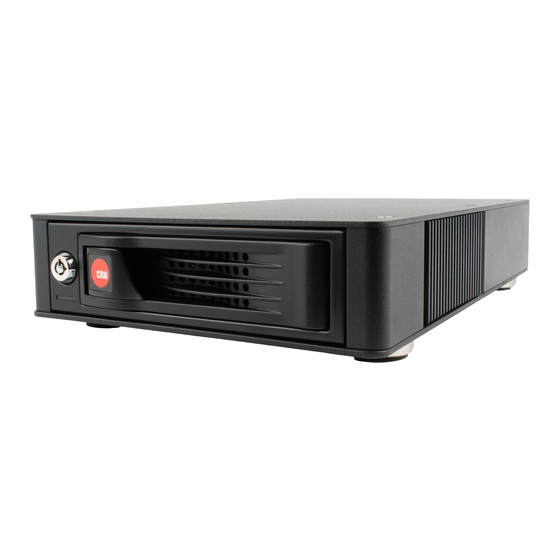
Table of Contents
Advertisement
Quick Links
RTX® 1-Bay 3Q
USER MANUAL
Revised March 4, 2013
Covers Models: RTX110-3Q, RTX Secure 110-3Q, RTX111-3Q, RTX Secure 111-3Q,
RTX112-3Q, RTX115-3Q, and RTX115DC-3Q (Digital Cinema)
Features
• Fast data connection options: USB 3.0, eSATA, and dual FireWire 800.
• Sturdy aluminum case provides excellent heat dissipation and rugged durability.
• Key lock secures drives during transport
• Models with encryption include a hardware-based real time encryption engine using AES,
the government approved encryption standard.
• Reliable 40mm cooling fan
• LEDs for drive power and access
R T X 1 - B a y - 3 Q U s e r M a n u a l A 9 - 1 1 0 - 0 0 0 1 R E V 2 . 0
- 1 -
Advertisement
Table of Contents

Summary of Contents for CRU Dataport RTX110-3Q
- Page 1 RTX® 1-Bay 3Q USER MANUAL Revised March 4, 2013 Covers Models: RTX110-3Q, RTX Secure 110-3Q, RTX111-3Q, RTX Secure 111-3Q, RTX112-3Q, RTX115-3Q, and RTX115DC-3Q (Digital Cinema) Features • Fast data connection options: USB 3.0, eSATA, and dual FireWire 800. • Sturdy aluminum case provides excellent heat dissipation and rugged durability.
-
Page 2: Table Of Contents
Table of Contents 1. Pre-Installation Steps 1.1 Accessories 1.2 Identifying Parts 2. Installation Steps 2.1 Installing Hard Drives 2.2 Connecting and Powering RTX1-bay-3Q 3. Encryption information (models with encryption only) 4. Usage with Mac and Windows Operating Systems 4.1 Usage with Mac OS X 4.1.1 Formatting a Drive 4.1.2 Mounting and Unmounting Volumes 4.1.3 Creating a Boot Drive... -
Page 3: Identifying Parts
1.2 Identifying Parts Take a moment to familiarize yourself with the parts of RTX1-Bay-3Q. This will help you to better understand the remaining instructions. RTX111-3Q, RTX110-3Q and RTX Secure 111-3Q RTX Secure 110-3Q and 112-3Q Power and Access LEDs Key Lock... -
Page 4: Connecting And Powering Rtx1-Bay-3Q
3.0). Choose one of those cables to use and plug it into the product. Connect the power cord to the product and to a grounded electrical outlet. NOTE: To connect RTX110-3Q to a USB 2.0 host, you must use a USB 2.0 cable. -
Page 5: Usage With Mac And Windows Operating Systems
4. Usage with Mac and Windows Operating Systems 4.1 Usage with Mac OS X 4.1.1 Formatting a Drive To format, use Disk Utility (pictured below), which can be found in the Applications folder. a) Click on the drive in the window to the left. b) Click the Erase tab in the window to the right. -
Page 6: Usage With Windows Operating Systems
4.2 Usage with Windows Operating Systems 4.2.1 Formatting a Drive When you first mount a drive to a Windows operating system, a pop-up window will ask you if you would like to format it. Click “Format Disk” and skip to Step F. If the prompt does not pop up, use the Disk Management utility by following these steps: a) Right-click on the My Computer icon on the desktop (Windows XP) or the Computer button in the Start Menu (Windows Vista, 7, Server 2008, Server 2008 R2, Server 2012), then select Manage. -
Page 7: Mounting And Unmounting Volumes
4.2.2 Mounting and Unmounting Volumes If the hard drive inside of the RTX carrier is already formatted, you can begin using the volume right away. When the RTX is properly connected and turned on, a window may open to allow you access to the volume. - Page 8 Q: Why is my hard drive experiencing data corruption? A: Many things can cause data corruption on hard drives, whether they are inside your computer or inside an external storage product. Malicious software, OS bugs, failure to properly disconnect external devices, or no reason at all.
-
Page 9: Technical Specifications
7. Technical Specifications RTX110-3Q, RTX Secure 110-3Q, RTX111-3Q, RTX Secure 111-3Q, Product names RTX112-3Q, RTX115-3Q, RTX115DC-3Q USB 3.0: up to 5.0 Gbps eSATA 3G: up to 3.0 Gbps Interface Types & Speeds* FireWire 800: up to 800 Mbps *Actual throughput is drive dependent.















Need help?
Do you have a question about the RTX110-3Q and is the answer not in the manual?
Questions and answers